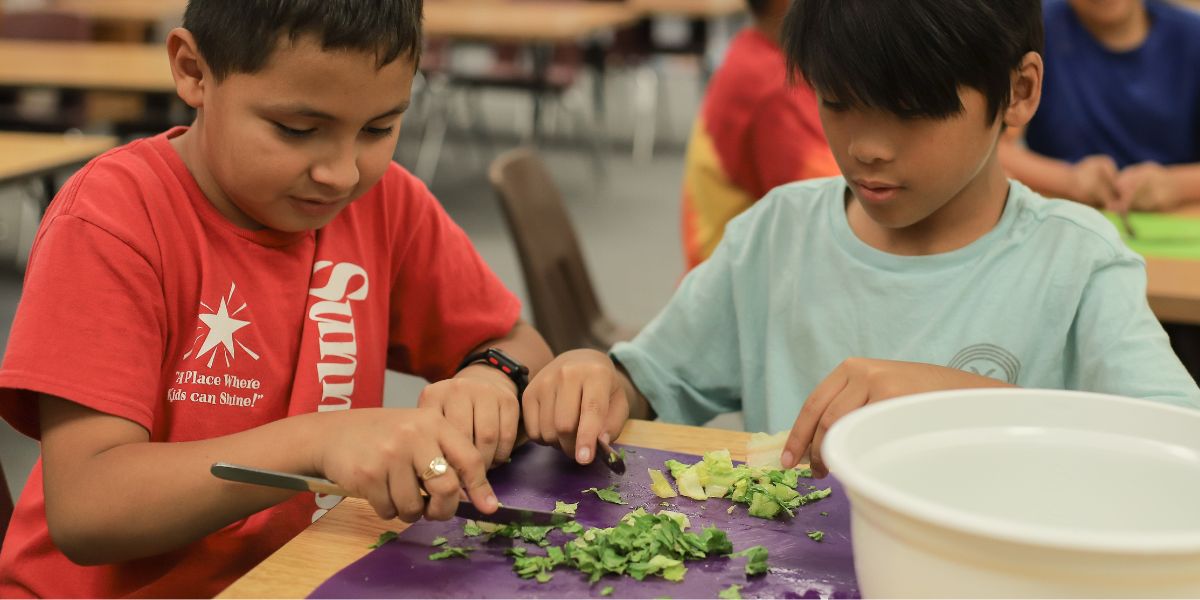At every healthy culinary workshop, we ensure that kids learn the essentials of kitchen safety.
The REAL reason we teach these guidelines in every single workshop is so that students can apply them when they cook one of our recipes at HOME. Our students, who typically attend Title-1 schools, need to learn the key life skill of making a meal from scratch using vegetables and simple ingredients, whether it’s Pasta Primavera with Zucchini or Black Bean & Spinach Quesadilla with Pico de Gallo.
These guidelines will help them have a cleaner and safer experience at home… and even adults should use them!
1. Chef Teachers Lean On Safety Standards (and Have Fun!)
Our Chef Teachers are always there for your students. They are trained not only to lead activities specifically designed for school-aged children but also to supervise closely, especially when students chop or add ingredients to the skillet. This supervision allows for immediate intervention if necessary and provides teachable moments to explain the reasons behind safety practices. This approach ensures that students learn in a fun and secure environment.
2. Emphasize Hand Washing and Surface Cleanliness
Good hygiene is the foundation of a safe kitchen. We teach students to wash their hands thoroughly with soap and water for at least 20 seconds before and after handling food. Additionally, we ensure that all cooking surfaces and utensils are clean to prevent cross-contamination. Our Chef Teachers demonstrate proper sanitizing techniques for cutting boards, knives, and countertops, instilling habits that students can carry into their home kitchens.
3. Teach Safe Knife Handling
In our healthy culinary workshops, students use low-risk instruments like butter knives to ensure safety while they experience the fun of dicing up fresh produce. Our Chef Teachers demonstrate proper knife techniques with a chef knife, teaching students to hold a knife like a wand for a solid grip. Students learn to walk with a knife facing down to the ground (just like with scissors) and never gesture while holding a knife. These practices help prevent accidents and promote safe kitchen behavior.
4. Promote Immediate Clean-Up of Spills
Slips and falls are common kitchen hazards, but they are easily preventable. We emphasize the importance of cleaning up spills as soon as they happen. We have paper towels or clean cloths around at all times for quick clean-ups. Keeping the kitchen floor dry and free of obstacles helps everyone stay safe as we move through the kitchen and different tasks.
5. The Paper Towel Trick
Speaking of paper towels…the paper towel trick is a simple yet highly effective safety measure that we teach all our students. Most cutting boards used at home tend to move around a lot, which can be dangerous when chopping ingredients. To stabilize the cutting board, we show students how to dampen a paper towel with a bit of water and place it underneath the board. This creates friction between the cutting board and the countertop, preventing the board from slipping.
This trick takes just a couple of minutes to set up but significantly enhances safety and ease of use. A stable cutting board makes chopping much more manageable and reduces the risk of accidents. Our Chef Teachers emphasize the importance of this trick in every session, ensuring students understand how such small steps can lead to a safer and more efficient cooking environment.
Excitement and Education
Encouraging safe practices in our program not only prevents accidents but also builds confidence and skills that students will carry with them for life. Our after-school program is where students not only learn to cook but do so in an environment that emphasizes safety and fun. We create a space where students can experiment with ingredients, master new techniques, and most importantly, learn to respect the kitchen as a safe and creative space. With every class, we ensure that safety is ingrained in every activity, turning each lesson into an adventure in culinary arts.
Book a meeting with us to learn more!
